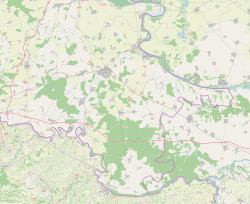Church of the Holy Venerable Mother Parascheva
Church of the Holy Venerable Mother Parascheva (Serbo-Croatian: Hram svete prepodobne majke Paraskeve, Serbian Cyrillic: Храм свете пеподобне мајке Параскеве) is a Serbian Orthodox church located in Banovci, Vukovar-Syrmia County in eastern Croatia. The neoclassical church was built in 1819. The church and its parish are under jurisdiction of the Eparchy of Srem which is based in Sremski Karlovci in neighbouring Serbia.[1] Most of the other Serbian Orthodox churches in Eastern Slavonia are under the ecclesiastical jurisdiction of Eparchy of Osječko polje and Baranja. The church is dedicated to Saint Parascheva of the Balkans.
| Church of the Holy Venerable Mother Parascheva | |
|---|---|
| Hram Svete prepodobne majke Paraskeve Храм свете пеподобне мајке Параскеве | |
 St. Petka orthodox church | |
 Church of the Holy Venerable Mother Parascheva Shown within Vukovar-Srijem County  Church of the Holy Venerable Mother Parascheva Church of the Holy Venerable Mother Parascheva (Croatia) | |
| 45°10′9″N 19°03′7″E | |
| Location | Banovci, Croatia |
| Country | Croatia |
| Denomination | Serbian Orthodox |
| History | |
| Dedication | Parascheva of the Balkans |
| Architecture | |
| Style | Neoclassicism |
| Years built | 1819 |
| Administration | |
| Archdiocese | Eparchy of Srem |
Lutheran Christmas Mass of 1859
First Danube Swabians settled in Banovci in 1859 where they were relying on the support of local Serbian Orthodox priest Uroš.[2] As the northern part of historical region of Syrmia was predetermined for German Catholic colonists, and settlement in the biggest part of Slavonian Military Frontier was almost impossible, German Protestants had to settle in the bordering region between these two jurisdictions.[2] As there was no Lutheran church in Banovci at that time, German Protestant settlers asked priest Uroš to hold a Christmas Mass for them under the Eastern Orthodox liturgical rite.[2] Priest Uroš have refused this request as it was contrary to Orthodox canonical rules, yet he offered them to organize Christmas Celebration on their own in the St. Petka church.[2] He also attended their celebration which impressed him but he did not lead the prayer.[2]
References
| Wikimedia Commons has media related to St. Petka's Church, Banovci. |
- "Архијерејско намесништво шидско". Archived from the original on June 10, 2007. Retrieved 2013-03-30.
- "Život i rad švapske obitelji Kettenbach u Novim-Šidskim Banovcima od doseljenja do Velikoga rata" (PDF). Archived from the original (PDF) on 21 June 2018. Retrieved 30 June 2018.






